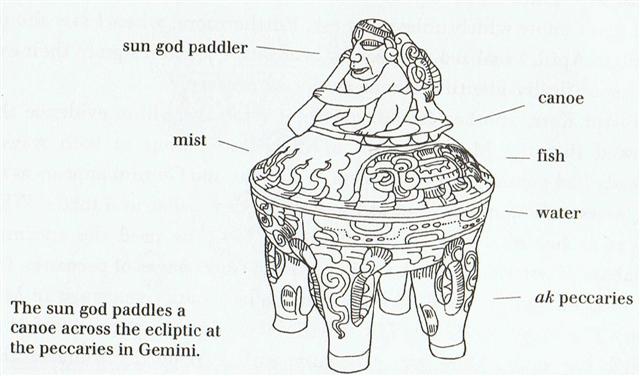|
TRANSLATIONS
Next page:
Gb2-16 has 4 'feathers' at left, but none at right, as if a 'fiery square' was signifying the first half of the year. 2 * 16 = 32 seems to allude to the 'black' number 32, one more than the maximum days in a month. The central 'stem' is thought-provoking. Why should there be a hole at the bottom? It the 'stem' means the 'world-tree' (which is reasonable), then a hole should be at the 'root' of the tree. Holes usually are filled with water if they are located deep down. The hole in the glyph does not mean that it is empty - it means there is no sun disc visible. The sun could be immersed. Beyond this point there must be rain, and rain is created by the sun. The sun is heating up the water down there in the hole, and up goes steam. The steam forms clouds and as they cool off the raindrops condense and fall back down again.
The steam is called mist here. The 'canoe' of the sun god seems to be buoyant by cause of being a kind of raft, where the ends of the 5 logs serve as a maitaki sign. In the week there are 7 days, and I think the structure of the week is reflected in the structure of the year, e.g.:
There are two faces on Mars. Also on moon and Venus, of course, but I guess we should count them as single days. I have tried to get 4 'balls' at left and 3 at right (with Saturn as not visible). Mercury is never high up in the sky, he does not count. He is a liquid and could be down in the hole. There are 42 glyphs in the calendar of the week according to H, but 36 is hidden as the real number (which proves a similarity with 360):
9 * 52 = 468, only 4 less thant 472. And 300 + 168 = 468. We can compare hipu in Hb9-52 with those in Hanga Te Pau and in Gb2-27:
In Gb5-12 the hipu sign was originally named pau (alluding to Puna Pau) by me. I was bothered by hipu being at left in Hb9-52, I could not find any reasonable explanation. Now I have found one: It indicates that tagata stands for the last glyph of the 'true' week, that part which is not in the dark. There cannot be a sign of future (right), because Saturn is completely black. In Gb5-12 the situation is different, because the 'black days' are in the past, there is a new light ahead. Hipu is a container, and it contains water = light stuff. I once pondered if the sun during a.m. was eating 'star stuff', e.g. in Ha5-52, but the truth is (of course) that he is consuming the steam produced by his 'fire':
In Gb2-27 the container has taken the place of the top left moon crescent sign. It is as if vai is coming forth from hipu. That is the natural sequence after hipu has played its role as container. Hipu and vai are two different entities, not as in Hb9-52 and Gb5-12 where hipu is an integrated sign of tagata. In Ha5-52 the eating gesture is likewise an integrated part of the sun himself. |
||||||||||||||||||||||||||||||||||||||||||||||||||||||||||||||||||||||||||||||||||||||||||||||||||||||

















